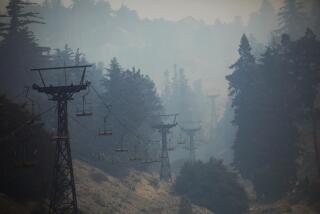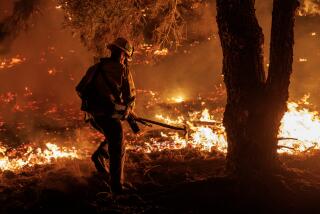Utah’s low-profile Solitude Mountain Resort
At last — a ski area suitable for our readers in the federal witness protection program.
Solitude Mountain Resort lies about 30 miles from downtown Salt Lake City, tucked into the same Wasatch range that harbors such famed ski destinations as Park City, Deer Valley and the Canyons. But Solitude occupies a different canyon and a different category. It makes less fuss and draws fewer people than most of those other resorts. Yet it gets just as much snow, often more. And as I found a few weeks ago, it gives skiers plenty to handle.
To reach Solitude, you fly to Salt Lake City and drive (or get driven) southeast, concluding with a careful cruise up curvy Big Cottonwood Canyon Road. As you near 8,000 feet above sea level, a little lodge will pop up on your right, then a pedestrian-only neo-Bavarian village. You have arrived at the retreat Ski magazine calls “North America’s most aptly named ski resort.”
Despite this low profile, Solitude’s mountain towers a little more than 10,000 feet, and by early December, when many Western ski resorts were just turning on the lights, Solitude already had its 65 runs open and 4 feet of snow on the ground. The annual average is about 500 inches.
When it comes to lodging, however, the resort is tiny. It has 46 hotel rooms and 212 condos, townhouses and vacation homes, all built between 1995 and 2009. In a 2010 ranking of the 30 biggest ski resorts in the Western U.S. and Canada, Ski magazine’s readers put Solitude near the top for weather and snow quality, near the bottom in dining, night life, off-mountain activities, lifts and terrain parks.
THE BEST WAY TO SOLITUDE
Many airlines (including American, Alaska, Continental, Delta, Frontier, Hawaiian, United, US Airways and Southwest fly nonstop from LAX to Salt Lake City. Also, Southwest and Delta fly from Burbank. Solitude lies in Big Cottonwood Canyon, neighboring the Brighton Resort, about 35 miles southeast of the Salt Lake City airport. For a fee, resort-area lodgings can arrange ground transport. If you rent a car in winter, it’s probably worth the extra cost to pay for four-wheel drive.
“The plus about Solitude is that you rarely have lines,” said Sherree Luke of Salt Lake City, a 15-year Solitude skier whom I found warming up by the resort’s Moonbeam Lodge fireplace. Especially in Solitude’s Honeycomb Canyon area, “you’re away from everyone,” she said. “It’s just like you’re out in the woods by yourself.”
Solitude offers eight lifts, serving about 1,200 skiable acres. About 20% of the slopes are suitable for beginners, 50% for intermediates and 30% for those in the “advanced/expert” category — a more beginner-friendly mix than at many of the 13 major resorts in Utah. The most ambitious Solitude skiers gravitate toward Honeycomb Canyon, which includes about 400 acres of lift-accessible, off-piste terrain. Begin at the top of the Summit lift and you have a 3.2-mile blue odyssey (that is, mostly intermediate difficulty) to the bottom of the Eagle Express lift. A day pass costs $68, versus $85 to $90 a day at the Canyons, Deer Valley or Park City (all of which have much more territory).
As for Solitude’s village, it’s handsome, especially the atmospheric clock tower. But it’s a resort, not a real town. If you’re cooking in one of the condos, you’ll need to buy groceries in Salt Lake City before entering the canyon. And though you’ll hear a pleasant tolling every 15 minutes that sounds like a church bell, it’s just a bit of recorded neo-Bavarian stagecraft — no church, no bell.
The village is better for couples and families than singles. It’s not a place to go shopping, and it’s a fair bet that nobody has ever gone there to see and be seen. Basically, it’s witness protection heaven, which I pointed out to resort spokesman Nick Como.
“How do you know that’s not why I’m here?” he asked.
I should say that I saw the place about as empty as it gets: late November, just a week after the resort opened for the season, before all the lifts were running, when just three of the village’s five restaurants were serving dinner and two of the four casual eateries on the mountain had yet to open. Traveling anonymously and paying the beginning-of-season rate of $169 a night, I was the Inn at Solitude’s first guest of the season.
I was also fortunate. Within a few hours of my arrival, the dense, gray sky dumped the season’s first serious snowstorm. Pretty soon, a foot of powder had fallen on an existing 2-foot snowpack, and the next day, a lucky few hundred of us had the responsibility of defiling it. Up, down, up, down, with scarcely a pause at the bottom. In two days, I never stood in a lift line for more than 60 seconds. (Instead of old-fashioned lift tickets, Solitude issues radio-frequency-identification pass cards with embedded electronic chips that you can leave in your pocket.)
“Lucky dog!” one of the lift attendants said as I edged up for my second run around 9:20 a.m. “I’ll be out there tomorrow.”
For two days, I skied green and blue (beginner and intermediate) runs until my thighs burned. After the first day, I headed for Kimi’s Mountainside Bistro, where I dined alone. Not alone at my table. Alone in the restaurant, except for the staff.
“When they say Solitude,” I thought, “they’re not kidding.” Then my food came, and I had another thought: “Great chanterelle mushroom soup.”
The next day, the storm was still on and conditions were stiffer, including gusts up to 50 mph that drove the snowflakes — and occasionally the skiers — sideways. Before long, the upper half of my face was numb and the lower half was stinging from the pelting flakes.
“This is, like, totally insane,” I heard a woman say on my way into the Moonbeam Lodge’s Argenta Pub. “I haven’t skied in powder like this in two years. It’s totally kicking my butt.”
“It’s a good kind of hurt,” said the man who was with her, paraphrasing the 20th century poet John Mellencamp.
Until the early 20th century, Big Cottonwood Canyon was known mostly for silver mining. In 1936, the canyon’s first ski area opened, Brighton, where many Utahans still learn to ski or snowboard. About two miles up the canyon from Solitude, Brighton draws young snowboarders, who line up next to local families chasing no-frill thrills. Management offers picnic tables for local skiers who bring their own lunches.
Solitude has a brown-bag dining area too — indoors, on the bottom level of its Snowsports Academy — and a great creation story that might even be true. In the 1950s, the story goes, a uranium tycoon from Moab, Utah, named Robert M. Barrett was visiting the Alta ski area in Little Cottonwood Canyon when nature called. Sorry, he was told, Alta’s restrooms are reserved for overnight guests. I don’t know how the uranium magnate met his immediate needs, but the upshot was that he resolved to open his own less-exclusive ski resort in Big Cottonwood Canyon. That was Solitude, which began with two chairlifts in 1957.
These days, the Alta experience still comes with restrictions. It’s one of the few winter resorts in North America that still bans snowboarders. Meanwhile, Solitude has grown to eight lifts, accepting skiers and boarders alike, with a mountain sports academy. Its Nordic ski center offers about 12 miles of cross-country trails and six miles of snowshoe trails.
Downhill skiers and boarders begin their days at the Solitude village area (where Sunrise and Apex Express lifts begin) or the Moonbeam Lodge, about a mile downhill (where the Moonbeam Express and Eagle Express lifts begin and where day-tripping locals park). The village and Moonbeam areas are connected by the Link lift and free shuttle-van service. In theory, the resort’s lifts can handle 14,450 skiers and boarders an hour.
In practice? “I don’t think we’ve ever had that many people here in a single day,” Como said.
Since the 1980s, the resort has been owned by Gary DeSeelhorst, who lives in the village with his wife, Betsy. Though the family doesn’t disclose details on operations, “most years, we make a small profit,” Como said.
On any given winter day, management says, about half the skiers and boarders at Solitude are locals. Apart from the units within Solitude, the principal lodging options in the canyon are the rustic, eight-room Silver Fork Lodge (which I liked the look of), the 20-room Brighton Lodge (which the storm prevented me from seeing) and several dozen vacation rentals.
In Solitude’s pedestrian village, the clock tower looms above about 10 buildings, which house the inn, spa, condos and homes; the lone retail shop (ski wear, mostly) and real estate office; Kimi’s Mountainside Bistro; St. Bernard’s (the fancy restaurant inside the Inn at Solitude); the Stone Haus Pizzeria & Creamery (which is more of a snack bar); and the Thirsty Squirrel pub, where I found a pair of the resort ski patrol’s avalanche rescue dogs, off duty but ready to help if I fell off my stool.
In the village’s Eagle Springs condo building, there’s a lounge area called Club Solitude, for condo and inn guests. It has a big fireplace, board games and movie screenings. It looks like a fine place to unwind, even if joining Club Solitude sounds a bit like running for president of the anarchists’ guild.
If you check out Solitude on Trip Advisor, you get mixed readings on the service in general, which I understand. Though I knew I’d miss a few things by arriving so early in the season, the reservationist didn’t make clear on the phone that the inn’s pool, hot tub, two fanciest dinner restaurants and the most convenient equipment rental shop would still be closed when I arrived. Once I was on the scene, however, everyone I met was cheerful and helpful — and I was especially happy to hand over a $20 tip to the hotel staffer who spent most of an hour digging my rental car out from under 2 feet of new snow.
“You don’t have the amenities that maybe some families from the East Coast and West Coast are looking for,” said Josh Dixon, a former Los Angeles resident who splits his time between Seattle and Park City. “You’re not going to find your Rodeo Drive-type shops. You have to go to Park City for that, or perhaps Vail, in Colorado. But the great thing about Solitude and the other resorts up in these canyons is it’s world-class skiing, and you’re just not paying for the amenities that are nice but not necessary.”
If you do feel like splurging, Solitude offers this: On any night but Monday for most of the winter, you can snowshoe or cross-country ski from the village through the early-evening darkness (for less than a mile) to a secluded round tent that’s lighted up like a Thomas Kinkade painting, if Thomas Kinkade painted Mongolian yurts.
That’s the Yurt restaurant, which seats no more than 22 diners, by reservation only. A chef does much of the food preparation in situ, with help from St. Bernard’s kitchen and a snowmobile. The five-course fixed-price meal is $100 — a lot for most people but chicken feed if you’re burning through a federal witness stipend.
More to Read
Sign up for The Wild
We’ll help you find the best places to hike, bike and run, as well as the perfect silent spots for meditation and yoga.
You may occasionally receive promotional content from the Los Angeles Times.







